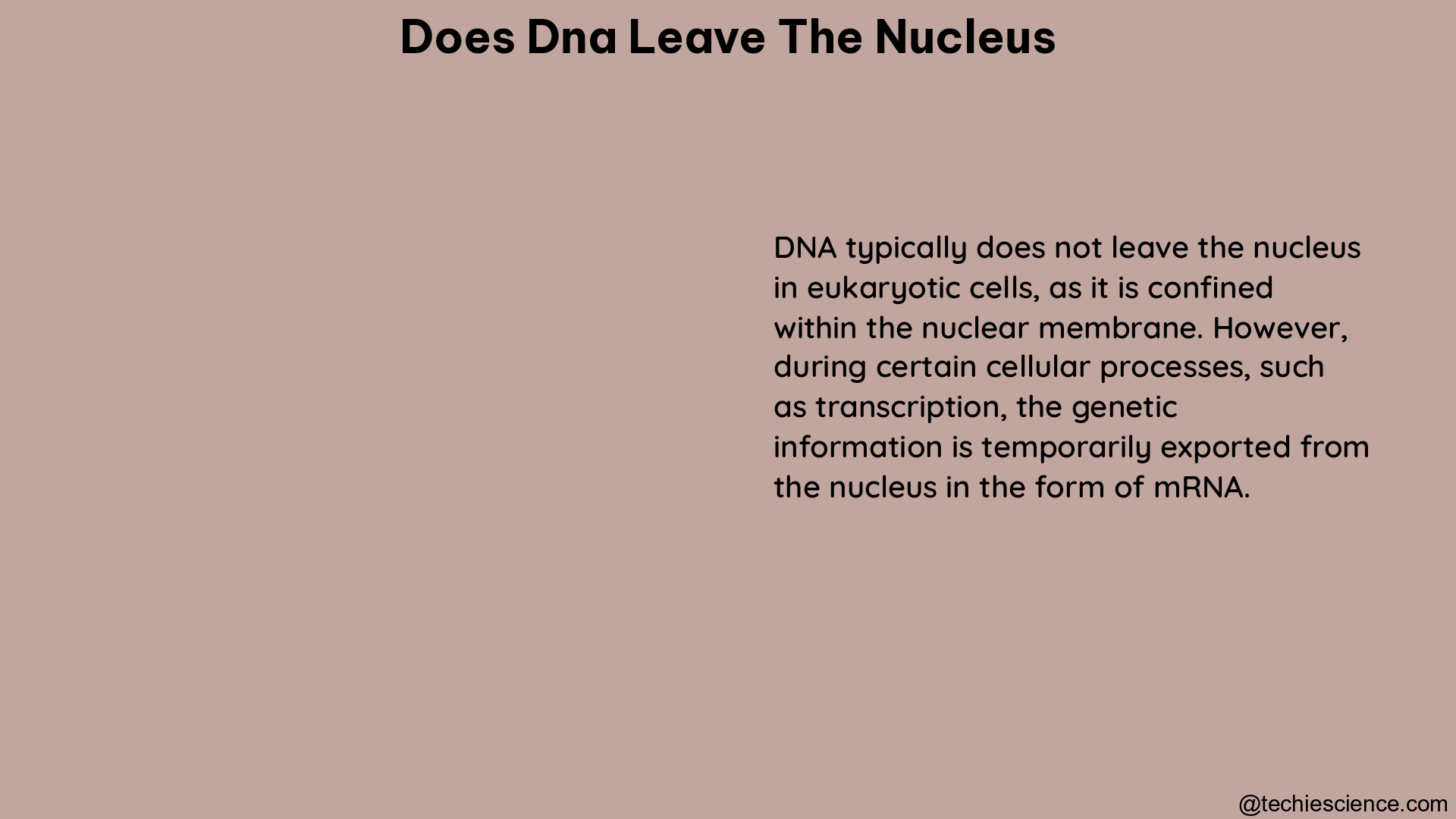DNA, the fundamental genetic material that carries the instructions for life, is primarily confined within the nucleus of a cell. The nucleus serves as a protective barrier, ensuring the integrity and stability of this vital biomolecule. However, the relationship between DNA and the nucleus is more complex than a simple containment. In this comprehensive guide, we will delve into the intricate details of whether DNA can leave the nucleus and the critical processes that govern its movement.
The Nucleus: DNA’s Protective Sanctuary
The nucleus is a highly specialized organelle found in eukaryotic cells, including those of plants, animals, and fungi. It is surrounded by a double-layered membrane, known as the nuclear envelope, which serves as a physical barrier between the genetic material and the cytoplasm. This nuclear envelope is perforated by nuclear pores, which allow the controlled movement of molecules in and out of the nucleus.
Inside the nucleus, DNA is tightly packed and organized into structures called chromosomes. The DNA molecule is wrapped around histone proteins, forming nucleosomes, which further condense into higher-order chromatin structures. This intricate packaging not only protects the DNA from damage but also facilitates the precise regulation of gene expression and other essential nuclear processes.
DNA Replication and Transcription: Processes within the Nucleus

DNA replication and transcription are two critical processes that occur exclusively within the nucleus. During DNA replication, the entire genome is faithfully duplicated, ensuring that each daughter cell receives a complete set of genetic information. This process is orchestrated by a complex machinery of enzymes and regulatory proteins, all of which are localized within the nuclear environment.
Transcription, the process of converting the genetic information encoded in DNA into messenger RNA (mRNA), also takes place within the nucleus. The enzyme RNA polymerase, along with various transcription factors, recognizes specific DNA sequences and initiates the synthesis of mRNA molecules. These mRNA molecules then serve as the working copies of the genetic information, carrying the instructions for protein synthesis to the cytoplasm.
The Exodus of mRNA: A Controlled Departure
While DNA itself does not typically leave the nucleus, a working copy of the genetic information, in the form of mRNA, does exit the nucleus to be translated into proteins in the cytoplasm. This controlled movement of mRNA is facilitated by the nuclear pores, which allow the selective transport of molecules between the nucleus and the cytoplasm.
The mRNA molecules are processed and modified within the nucleus before being exported. This processing includes the addition of a 5′ cap, the removal of non-coding introns (splicing), and the addition of a poly(A) tail. These modifications ensure the stability and proper recognition of the mRNA by the cellular machinery in the cytoplasm.
Once the mRNA is ready, it is recognized by specific transport proteins and shuttled through the nuclear pores into the cytoplasm. In the cytoplasm, the mRNA is then read by ribosomes, the cellular organelles responsible for protein synthesis, to produce the corresponding proteins.
Variability in Nuclear DNA Content
While DNA itself does not leave the nucleus, studies have shown that the amount of DNA within the nucleus can vary during different stages of the cell cycle. A study conducted on a growing fungus measured the DNA content per nucleus, and the levels ranged from 3 to 6 picograms (pg) per nucleus.
This variability in DNA content is primarily due to the cell cycle and the process of DNA replication. During the G1 phase of the cell cycle, the cell contains a single set of chromosomes, resulting in a DNA content of around 3 pg per nucleus. As the cell progresses through the S phase, the DNA is replicated, leading to a doubling of the DNA content to around 6 pg per nucleus.
It is important to note that this variation in DNA content does not indicate that the DNA itself is leaving the nucleus. Instead, it reflects the dynamic nature of the cell cycle and the precise regulation of DNA replication within the nuclear environment.
Cytoplasmic Regulation of Protein Production
While the nucleus is the site of DNA storage and transcription, the primary regulation of protein production occurs within the cytoplasm, not the nucleus. A breakthrough study has revealed the critical role of cytoplasmic protein factories, known as ribosomes, in orchestrating cellular functions and responding to pathological perturbations.
Ribosomes, the cellular organelles responsible for protein synthesis, are located in the cytoplasm. These protein factories read the mRNA molecules that have been exported from the nucleus and translate the genetic information into functional proteins. The regulation of protein production, including the rate of translation, the stability of mRNA, and the post-translational modifications of proteins, is largely controlled by the cytoplasmic environment.
This finding highlights the importance of the cytoplasm in the overall cellular function and the dynamic interplay between the nucleus and the cytoplasm in the regulation of gene expression and protein production.
Conclusion
In summary, while DNA itself does not typically leave the nucleus under normal circumstances, a working copy of the genetic information, in the form of mRNA, does exit the nucleus to be translated into proteins in the cytoplasm. The nucleus serves as the protective sanctuary for DNA, ensuring its integrity and facilitating the critical processes of DNA replication and transcription.
The variability in nuclear DNA content observed in studies is a reflection of the cell cycle and the precise regulation of DNA replication, rather than the direct movement of DNA out of the nucleus. Additionally, the primary regulation of protein production occurs within the cytoplasm, highlighting the dynamic interplay between the nucleus and the cytoplasm in the overall cellular function.
Understanding the intricate relationship between DNA and the nucleus is crucial for comprehending the fundamental mechanisms of life and the complex regulatory networks that govern cellular processes. This knowledge not only advances our scientific understanding but also has important implications in fields such as genetics, molecular biology, and biotechnology.
References:
– Measurements of the amount of DNA per nucleus were taken on a large number of cells from a growing fungus. The measures of DNA levels ranged from 3 to 6 picograms per nucleus.
– mRNA is a working copy of DNA that leaves the nucleus.
– The primary regulation of protein production occurs within the cytoplasm, not the nucleus.
– Variability in nuclear DNA content during the cell cycle.
– The nucleus serves as the protective boundary for DNA.

Hi… I am Kaushani Misra, a Postgraduate in Biochemistry, and aspire to be an academic. Driven by curiosity and passion for science I enjoy learning new things and writing about them.